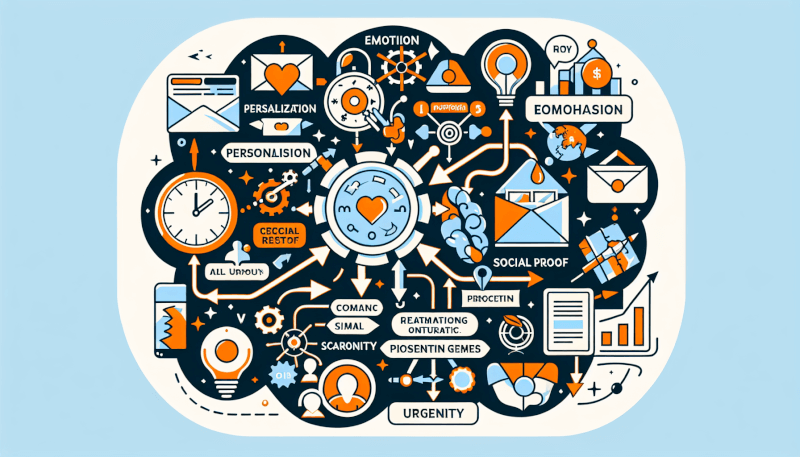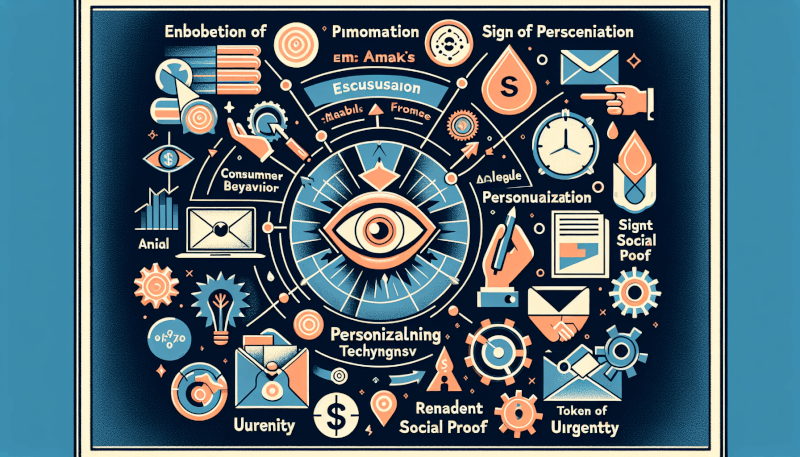Imagine if you had the power to create compelling email campaigns that effortlessly persuaded your readers to take action. Unlocking the secrets of the psychology behind email marketing can do just that. By understanding the subtle persuasion techniques that influence our subconscious minds, you can craft emails that captivate your audience and drive conversions. In this article, we will explore the fascinating world of email marketing psychology and discover how to master the art of persuasion through your digital communications. So, grab a cup of coffee and let’s dive into the captivating world of psychology behind email marketing.

Importance of Understanding Psychology in Email Marketing
Email marketing is a powerful tool for businesses to connect with their audience and build strong relationships. However, in order to effectively reach and engage subscribers, it is crucial to understand the psychology behind their behaviors and motivations. By gaining insight into the psychological factors that influence decision-making and purchasing behavior, you can tailor your email marketing strategies to meet the needs and desires of your subscribers. This article will explore various psychological techniques and strategies that can be utilized in email marketing to enhance its effectiveness and drive desired outcomes.
Building a Strong Connection with Subscribers
Establishing a strong connection with your subscribers is essential for the success of your email marketing campaigns. When subscribers feel a genuine connection to your brand, they are more likely to engage with your emails, trust your recommendations, and ultimately make purchases. To build this connection, it’s crucial to understand your subscribers’ motivations, desires, and pain points.

Understanding Subscribers’ Motivations
In order to effectively connect with your subscribers, it’s important to understand their motivations. People are driven by various factors, such as the desire for success, the need for belonging, or the fear of missing out. By identifying and leveraging these motivations in your email marketing campaigns, you can create targeted and personalized content that resonates with your audience on a deeper level.
Creating a Sense of Urgency
One effective psychological technique in email marketing is creating a sense of urgency. By emphasizing limited-time offers or exclusive deals, you can tap into subscribers’ fear of missing out and motivate them to take action. Urgency can be created through compelling subject lines, time-limited promotions, or limited stock availability. By incorporating urgency in your email marketing campaigns, you can drive higher open rates, click-through rates, and conversions.

Cognitive Biases in Email Marketing
Cognitive biases are the inherent shortcuts that our brains take when processing information and making decisions. They are a result of our subconscious biases and can have a significant impact on our behaviors and choices. Leveraging these biases in email marketing can help to capture and hold subscribers’ attention, increase engagement, and drive conversions.
Anchoring Bias
Anchoring bias is the tendency for individuals to rely too heavily on the first piece of information presented when making decisions. In email marketing, this can be utilized by leveraging the power of the initial impression. By positioning your most compelling offer or key message at the beginning of your email, you can anchor subscribers’ perceptions and influence their decision-making process.
Availability Heuristic
The availability heuristic is a mental shortcut that individuals use to make judgments based on the most readily available information in their memory. In email marketing, you can tap into the availability heuristic by using social proof. By showcasing testimonials, reviews, or user-generated content in your emails, you are providing tangible evidence of your brand’s value and credibility, making it easier for subscribers to trust your offerings and make purchasing decisions.
Confirmation Bias
Confirmation bias is the tendency for individuals to seek information that confirms their preexisting beliefs and ignore information that contradicts them. In email marketing, you can leverage confirmation bias by aligning your messages with the preconceived notions and desires of your subscribers. By understanding their interests and preferences, you can tailor your email content to confirm their beliefs, reinforcing their positive perception of your brand and increasing their likelihood of engaging and converting.
Scarcity Effect
The scarcity effect is the psychological principle that individuals perceive items or opportunities as more desirable when they are scarce or limited. In email marketing, you can leverage the scarcity effect by creating a sense of exclusivity or limited availability. By highlighting limited stock, time-limited promotions, or exclusive access to certain products or content, you can trigger a fear of missing out in your subscribers and motivate them to take action.
Framing Effect
The framing effect is the concept that the way information is presented can significantly influence the way individuals perceive and evaluate it. In email marketing, the framing effect can be utilized by emphasizing the positive benefits or outcomes that subscribers can achieve by taking the desired action. By framing your email copy in a way that highlights the value and benefits, you can influence subscribers’ perceptions and encourage them to engage with your emails.
Social Proof in Email Marketing
Social proof is a powerful psychological phenomenon that refers to our tendency to look to others for guidance in determining our own behaviors and decisions. By incorporating social proof in your email marketing campaigns, you can create a sense of trust, credibility, and validation among your subscribers, ultimately driving higher engagement and conversions.
Utilizing Testimonials and Reviews
One way to leverage social proof in email marketing is by showcasing testimonials and reviews from satisfied customers. By including positive feedback and real-life experiences in your emails, you provide tangible proof of the value and quality of your products or services. This can help to build trust and credibility among your subscribers, making them more likely to engage with your emails and make purchasing decisions.
Providing Social Share Buttons
Including social share buttons in your emails allows subscribers to easily share your content with their network, further expanding your reach and visibility. When subscribers see that others are sharing and engaging with your emails, it creates a sense of social proof and validates the quality and relevance of your content.
Displaying Subscriber Count
Displaying the number of subscribers or followers you have can also be a powerful form of social proof. When subscribers see that a large number of people have chosen to engage with your brand and receive your emails, it creates a sense of trust and credibility. This can encourage them to join your community and become more engaged with your email campaigns.

Reciprocity and Email Marketing
Reciprocity is a fundamental principle of human behavior that refers to the tendency to respond to a positive action with another positive action. By leveraging the power of reciprocity in your email marketing campaigns, you can create a sense of goodwill and gratitude among your subscribers, fostering stronger relationships and driving higher engagement.
Offering Valuable Content or Resources
Providing valuable and relevant content or resources to your subscribers is a powerful way to leverage reciprocity. By offering exclusive access to insightful articles, helpful guides, or useful tools, you are demonstrating your expertise and providing tangible value to your subscribers. This can trigger a sense of reciprocity, motivating them to reciprocate by engaging with your emails, sharing your content, or making purchases.
Exclusive Deals and Discounts
Another effective way to leverage reciprocity in email marketing is by offering exclusive deals or discounts to your subscribers. By providing them with special offers or access to limited-time promotions, you are rewarding their loyalty and making them feel special. This can create a sense of reciprocity, driving higher open rates, click-through rates, and conversions.
Creating Emotional Appeal in Emails
Emotions play a significant role in our decision-making process, and leveraging emotional appeal in email marketing can be a powerful way to connect with your subscribers on a deeper level. By tapping into their emotions, you can create a memorable and impactful email experience that motivates action and drives engagement.
Storytelling and Personalized Narratives
Storytelling is a powerful tool in email marketing to create an emotional connection with your subscribers. By sharing personal anecdotes, success stories, or customer journeys, you can engage your subscribers on an emotional level, evoking empathy, inspiration, or excitement. Personalized narratives can help to humanize your brand and make your emails more relatable and memorable.
Using Emotional Language and Imagery
The language and imagery used in your emails can also evoke powerful emotions and influence subscribers’ perceptions and behaviors. By using words and phrases that evoke positive emotions, such as joy, love, or excitement, you can create a positive association with your brand and offerings. Additionally, incorporating visually appealing and emotionally compelling images can further enhance the impact of your emails and leave a lasting impression on your subscribers.

Behavioral Psychology and Email Marketing
Behavioral psychology focuses on understanding how our behaviors are influenced by our environment, experiences, and interactions. By leveraging the principles of behavioral psychology in email marketing, you can nudge subscribers towards desired actions and create a more engaging and personalized experience.
Leveraging the Power of Habits
Habits are automatic routines or behaviors that individuals perform without conscious thought. By understanding your subscribers’ habits and incorporating them into your email marketing campaigns, you can increase engagement and drive desired actions. For example, if you know that a significant portion of your subscribers check their emails in the morning, you can schedule your emails to be delivered at that time to increase open rates and engagement.
Creating Behavioral Triggers
Behavioral triggers are stimuli or cues that prompt individuals to take a specific action. By strategically incorporating behavioral triggers in your email marketing campaigns, you can guide subscribers towards desired actions. For example, including a clear and prominent call-to-action button can serve as a behavioral trigger that prompts subscribers to click and engage with your emails.
The Power of Personalization in Email Marketing
Personalization is a key aspect of effective email marketing. When subscribers receive personalized and relevant content, they are more likely to engage with your emails and take the desired actions. By leveraging segmentation, dynamic content, and recommendations, you can create a personalized and tailored email experience that resonates with your subscribers.
Segmentation and Personalized Messaging
Segmentation involves dividing your subscribers into smaller groups based on their demographics, preferences, or behaviors. By segmenting your email list and sending targeted messages to specific segments, you can deliver content that is highly relevant and personalized to each subscriber. This increases the likelihood of engagement and conversions, as subscribers feel that the emails are specifically tailored to their needs and interests.
Dynamic Content and Recommendations
Dynamic content allows you to deliver personalized content to your subscribers based on their past interactions, preferences, or behaviors. By dynamically changing the content of your emails based on individual subscriber data, you can create a more personalized and engaging experience. Additionally, incorporating product recommendations or personalized offers based on subscribers’ browsing or purchase history can further enhance the relevance and effectiveness of your email campaigns.
Motivational Factors in Email Marketing
Motivation is a key driver of human behavior, and understanding the motivational factors that influence your subscribers can help you create targeted and compelling email campaigns. By setting clear goals and objectives and incentivizing action, you can motivate subscribers to engage with your emails and take the desired actions.
Setting Clear Goals and Objectives
By setting clear goals and objectives for your email marketing campaigns, you provide a sense of direction and purpose. Whether it’s increasing sales, driving website traffic, or boosting brand awareness, having clear goals helps to focus your email content and calls-to-action, ensuring that every element of your email campaign is aligned towards achieving those objectives.
Incentivizing Action
Incentives can be a powerful motivator for subscribers to engage with your emails and take the desired actions. By offering incentives, such as discounts, freebies, or exclusive access to content or resources, you create a sense of value and reward for subscribers. This can motivate them to open your emails, click on your links, or make purchases, ultimately driving higher engagement and conversions.
Influencing Subject Lines and Email Copy
The subject line and email copy are critical elements of your email marketing campaigns that can significantly impact open rates, click-through rates, and engagement. By leveraging psychological techniques in your subject lines and email copy, you can capture attention, spark curiosity, and compel subscribers to take action.
Curiosity and Intrigue
Humans are naturally curious beings, and leveraging curiosity in your subject lines can be an effective way to grab subscribers’ attention. By posing intriguing questions, teasing valuable information, or creating a sense of mystery, you can pique subscribers’ curiosity and compel them to open your emails to satisfy their need for closure and knowledge.
Urgency and Scarcity
As mentioned earlier, creating a sense of urgency and scarcity can be a powerful motivator in email marketing. By incorporating words and phrases that convey urgency or highlight limited availability, such as “Last chance!” or “Limited stock remaining!”, you can trigger a fear of missing out and compel subscribers to take immediate action.
Emphasizing Benefits
Instead of focusing solely on the features of your products or services, it’s important to emphasize the benefits that subscribers will gain by engaging with your emails or purchasing your offerings. By highlighting the specific benefits and value that subscribers can expect, you create a stronger emotional connection and make it easier for them to understand the value proposition of your brand.
Analyzing and Optimizing Email Campaigns
Analyzing and optimizing your email campaigns is essential for improving their effectiveness and achieving desired outcomes. By incorporating A/B testing and data-driven strategies, as well as tracking and analyzing subscriber behavior, you can gain valuable insights and make informed decisions to enhance the performance of your email campaigns.
A/B Testing and Data-driven Strategies
A/B testing involves sending two versions of an email to a small segment of your subscribers and analyzing which version performs better in terms of open rates, click-through rates, or conversions. By systematically testing different variables, such as subject lines, call-to-action buttons, or email design, you can identify the most effective strategies and optimize your emails for maximum performance.
Tracking and Analyzing Subscriber Behavior
Tracking and analyzing subscriber behavior provides valuable insights into their preferences, engagement patterns, and purchasing behaviors. By tracking metrics such as open rates, click-through rates, and conversion rates, you can identify trends and patterns that can guide your email marketing strategies. Additionally, monitoring subscriber interactions with your emails, such as email opens, link clicks, or purchase behaviors, can help you understand the effectiveness of your campaigns and make data-driven decisions to optimize future campaigns.
In conclusion, understanding the psychology behind email marketing is essential for building strong connections with subscribers, driving engagement, and motivating desired actions. By incorporating psychological techniques such as social proof, reciprocity, emotional appeal, behavioral psychology, personalization, motivational factors, and persuasive copywriting, you can create more effective and impactful email marketing campaigns. Additionally, analyzing and optimizing your email campaigns through A/B testing and data-driven strategies ensures continuous improvement and better results. By leveraging the power of psychology in your email marketing efforts, you can connect with your subscribers on a deeper level, enhance their email experience, and drive meaningful outcomes for your business.


